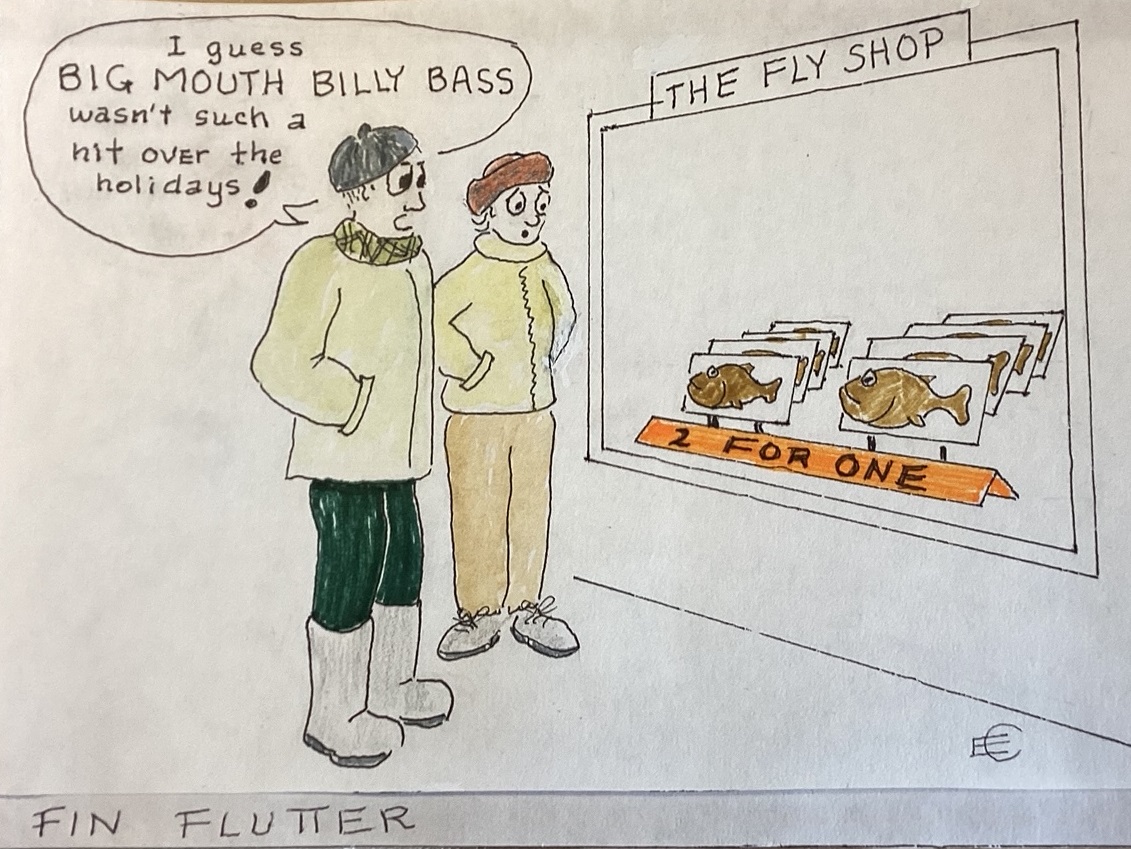
This one is for the steelhead fishers, who tell us all the time how much fun they’re having!
Posted on December 27th, 2023

This one is for the steelhead fishers, who tell us all the time how much fun they’re having!
Posted on December 27th, 2023
2024 Annual Dinner & Fundraiser………………
General Meeting……………………
Lance Gray
December Raffle……………………
President’s Line……………………
Fly Tying……………………
December Class: Trout Nugget
Fly of the Month: Tying Tips
Conservation Concerns……………
SCFF Volunteers on Little Arthur Creek
Membership Notes…………………
Club Activities – December
2024 membership renewals
Fishout Schedule…………………
Cartoon ……………………
Posted on November 29th, 2023
followed by
557 1/2 LAKEVIEW RD. , WATSONVILLE
ANNUAL. FUND RAISER COORDINATOR: DAVID SOUTH (831)713-5866 (831)234-0196
DINNER TICKETS: Are $40 and have already sold out..
VOLUNTEERS: Many long-term club members say that the best part of our event is the time volunteering, and working with others to put the whole event together. Contact Elaine Cook at (831)231-6515 or (831)-251-4741, or coookin@gmail.com (no text please) to find out how you can best help.
DONATIONS: Our club would be grateful for donations to be used as raffle prizes at our annual fundraiser. Examples: flies you have tied, other handcrafted items, business services, personal services such as fly-tying lessons, casting lessons, etc. If you have such a contribution, please contact our annual raffle coordinator Rick Chace, at (831)234-9200.
RAFFLE TICKETS: Can be purchased online when buying your dinner ticket (which will be issued at the door),or at our event. Two door prizes of 50 raffle tickets will be awarded, which should increase your chances of winning. There will be silent auction items as well.
ABOUT THE ROD AND GUN CLUB: it’s located in a rural setting overlooking Kelley lake. The parking lot is gravel so not a problem if it’s raining. Their insurance doesn’t permit us to bring alcohol. However, there is a cash bar where drinks and sodas can be purchased.
SO ALL IN ALL, COME SUPPORT YOUR CLUB, AND DON’T MISS OUT ON THE FUN.
Ticket purchasers : (as of Jan 25, 1:00 pm)
Asterisk means that the person paid by cash or check. Did not purchase through website.
Pajaro Valley Rod & Gun club is located 14 miles south of the Aptos Grange.
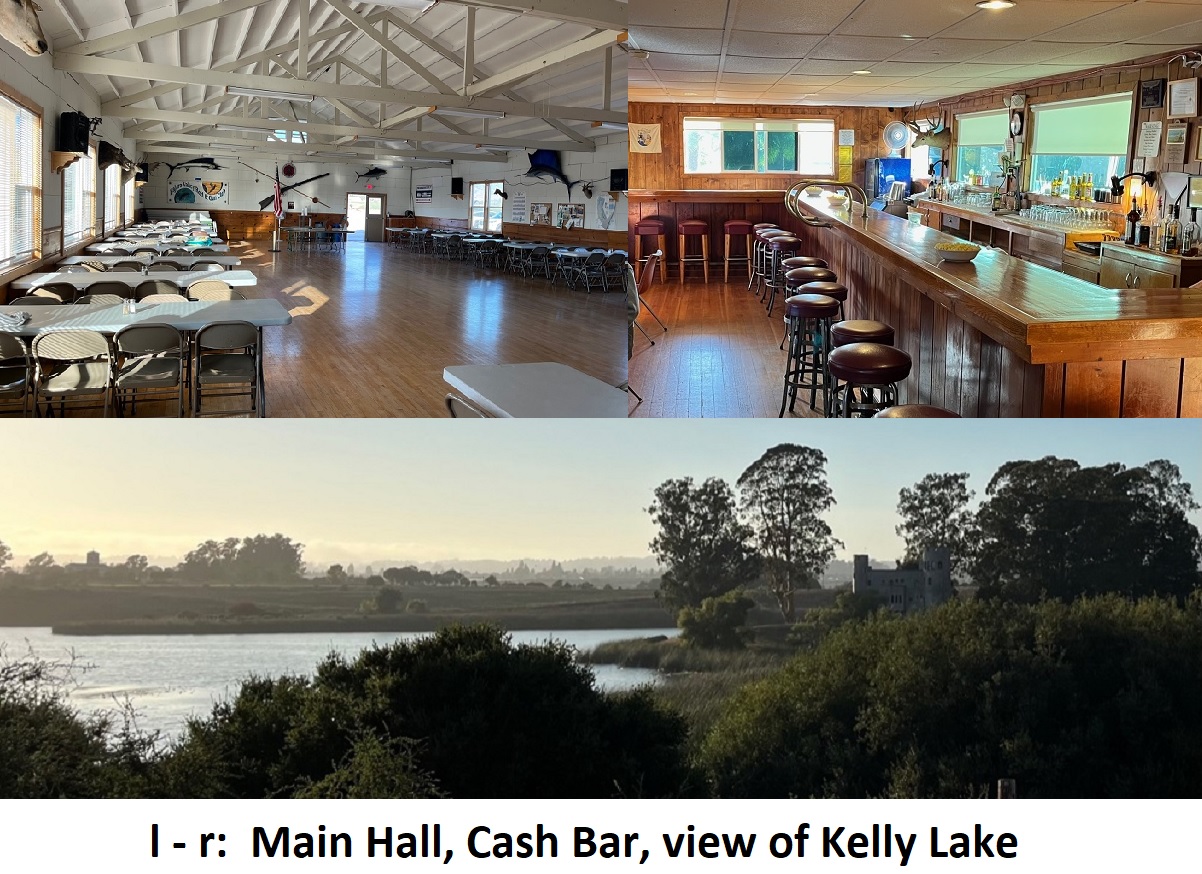
Posted on November 29th, 2023
Zoom link: https://us06web.zoom.us/j/89352294939
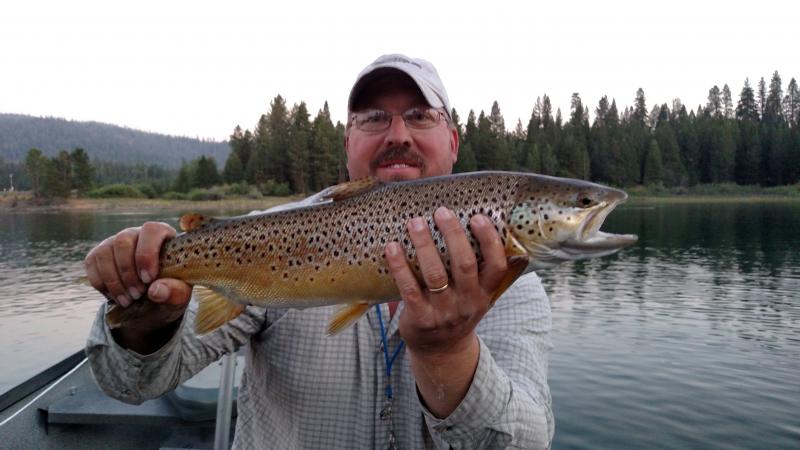
During 2003, Lance and Kirsten Gray launched Lance Gray & Co., a full-service outfitter offering guided trips, fly-fishing schools, workshops and a travel agency. His guide service covers Lake Almanor, Manzanita Lake, and the Yuba, Lower Sac and Feather rivers. Lance is a signature tier for Aqua Flies, pro staff member for Sage and Rio and is a featured writer, with articles published in Angling Trade Magazine, California Fly Fisher, Fly Fishermen, Sierra Fisherman and Northwest Fly Fishing.
Lance and Kirsten together have more than a combined 50 years of experience in fly fishing. Lance started fly fishing with his father and brother Lincoln at age 7. In his teens, he began tying flies commercially for shops all around Northern California. During 1993, Lance and Kirsten started Saltwater Innovations, a manufacturer and distributor products for saltwater fly fishing. Lance’s Crystal Popper, Gray’s Billfish Fly, the KO Charlie line and the Raghead Crabs are all Saltwater Innovations products. Kirsten worked behind the scenes, handling day-to-day operations and running the manufacturing floor.
| Monthly Speaker | Date | Excerpt |
|---|---|---|
| Jan 03 | Club Meeting |
Posted on November 29th, 2023
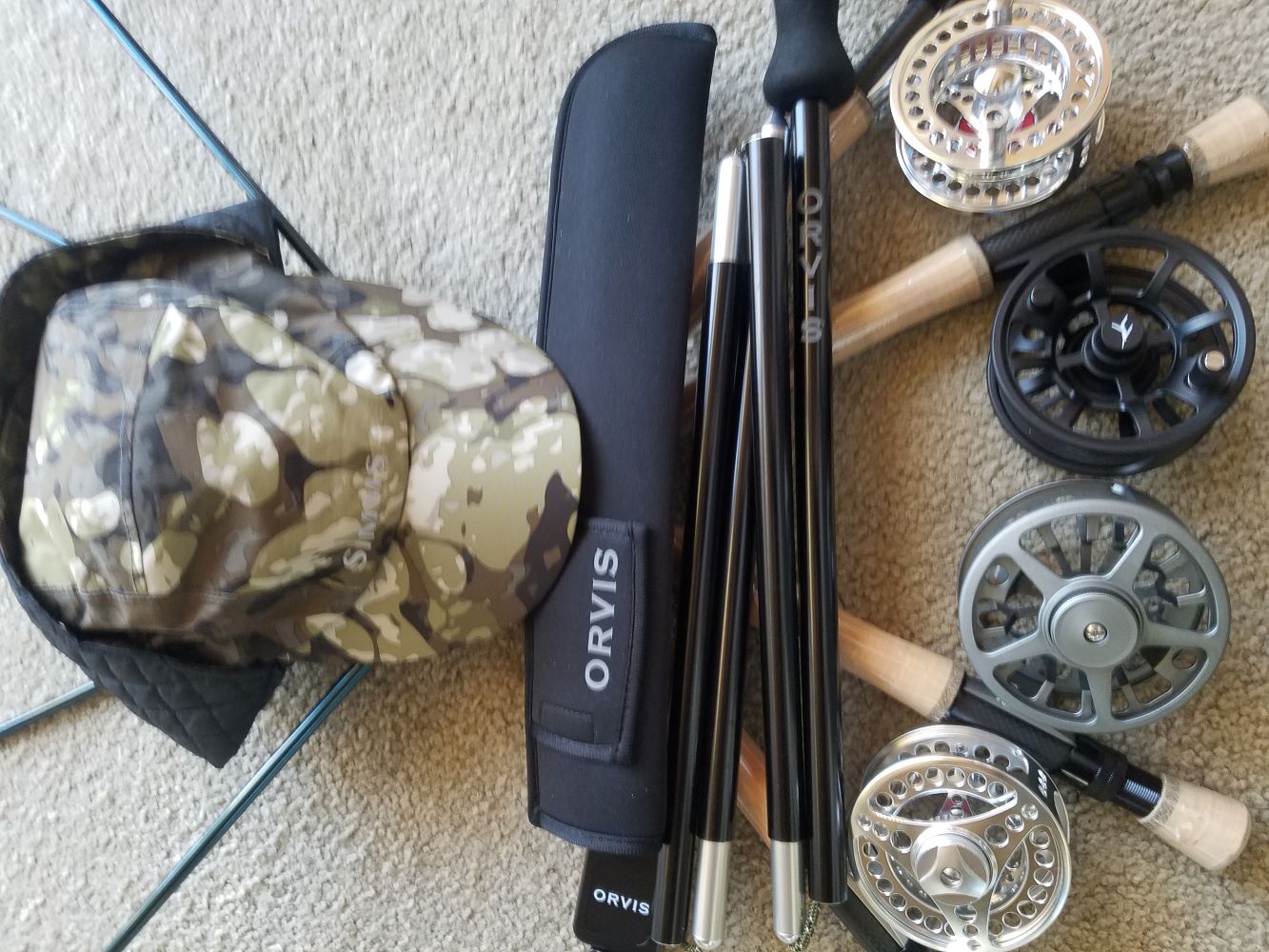
What is the best way to win your own Christmas present? Buy a bunch of raffle tickets for the drawing at the meeting on Wednesday, December 6th!
Naughty or nice, Santa doesn’t care. Buy a raffle ticket and be a winner!
We just got in a bunch of really nice V-Access rods; 9 ft. 4 piece with hard chrome guides, AA cork handles, and K-carbon tube aluminum reel seats. They each include a hard protective zippered tube case. Each rod is paired with either an AG or Anatono matching reel.
TWO! rod/reel packages will be given away by winners choice. Pick between a 5 wt, 6wt,7wt, or 8wt. rod. There will be 4 different rods to choose from, a total of 2 two rod/reels will be awarded.
Wintertime fishing means Steelhead fishing which also means river wading.
When river wading for Steelhead or other creek and stream inhabitants it is always a good idea to make use of a quality wading staff. From Orvis we have an American-made collapsing wading staff which includes a heavy duty Orvis zinger tether and neoprene belt sheath. A great aid in keeping safe and stable on the water.
Speaking of wintertime fishing or even on a ladder in April at Pyramid, take a look at this quilted Primaloft insulated Gortex Veil Camo hat from Simms. Warm and waterproof with secure earflaps, this headgear will keep you on the fish during the worst weather out there. As is said,”Don’t change your plans, change your clothes “.
Don’t miss out on these great raffle prizes. Tickets are a dollar each, $20 bucks gets you 25. Click on the following link to purchase your lucky raffle tickets:
The online ticket sales office will close at noon on Wednesday the day of the Fly Club meeting. The drawing will take place at the monthly meeting (12/6/23) held at the Aptos Grange. Club membership is not required to participate, need not be present to win.
Participation in the monthly raffle helps support your Fly Club and is greatly appreciated.
Posted on November 29th, 2023
I have been told that the Santa Cruz Fly Fishing club has been doing an Annual Dinner and Fundraiser since way back in 1992. Last year’s lunch event was fun, but lacked the opportunity to have a sit down dinner with a lot of members of the club. Your board has been busy preparing for the February 3rd event and I just wanted to share with you some of what we are doing to make it happen and what you can do to help.
Wild Salmon Dinner
Securing a wild-caught salmon dinner has become more challenging due to the closure of the California fishery last year. However, for our upcoming dinner, dedicated members flew to a remote part of Alaska to obtain our salmon.. Below is Sam catching our dinner.
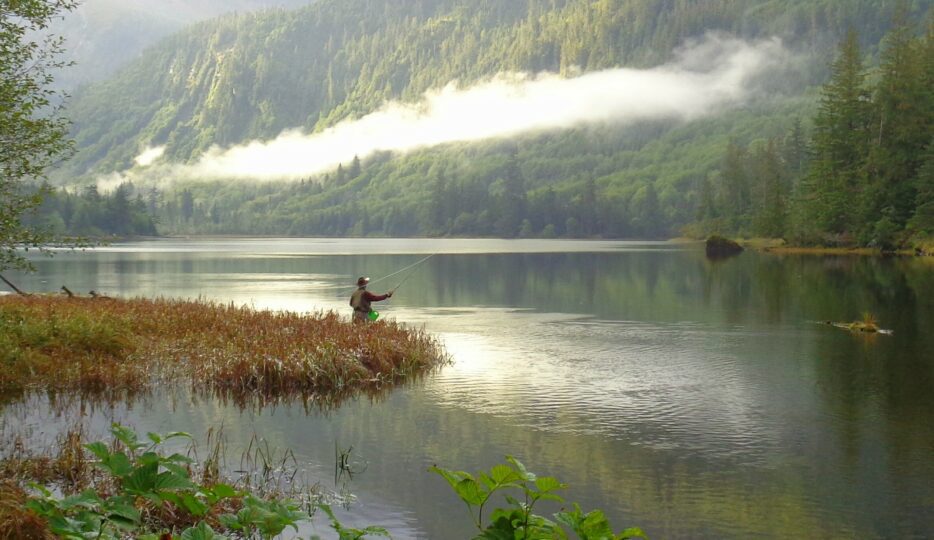

Along with the salmon, we will be serving salad courtesy of California Grill/Lakeside Organic Gardens. The Peixoto run the largest family-owned organic farm in the US and grow most of their vegetables around Watsonville including decades at my family’s farm. Along with the fish and Salmon, Dave South has been busy sourcing the rest of the dinner from local, organic vendors around the county. And Elaine Cook is organizing a team to prepare delightful appetizers for everyone to enjoy while perusing the prizes, purchasing additional raffle tickets, and mingling with fellow attendees.
Raffle Prizes
Oh do we miss John Steele. For many, many years, John, would shop sales, fix equipment and create wonderful art work for the Annual Dinner. John had big shoes to fill, so we so we got a big man, Rick Chace, to step into the role. We are still acquiring prizes, but from what I have seen, there is going to be some nice stuff and a lot of it: at least 16 rods, 4 float tubes, tons of fly tying material, and boxes full of flies. We are hoping to get more non-fishing prizes for the raffle and welcome any donations from the membership. Maybe a gift certificate for a product or service? A piece of art? Bottle of wine? If you have any donation, please contact Rick Chace (rchase@got.net) or (831) 234-9200.
Unlike our monthly raffles, you must be present to win, ensuring that you’re only competing against others in the room. Our goal is for everyone to leave with something.
New Location
For years, the dinner has taken place at a church in Santa Cruz. Unfortunately, post-Covid, that location is no longer practical. After exploring various alternatives, we found a fantastic venue with ample space, full bar service, and a large BBQ pit for cooking the salmon. The only downside is its location at the south end of Santa Cruz county, near the Santa Cruz Fairgrounds (the location and map are available in the article about the dinner).
For those traveling from a distance, consider staying overnight nearby. The new Hampton Inn off Riverside is a suggestion. Other viable options in Watsonville include the Holiday Inn Express on Main St and the Comfort Inn near the Airport. Sunset Beach and KOA offer campsites for RVs or fancy vans. Alternatively, you could collaborate with other members to rent an Airbnb at Pajaro Dunes and enjoy some beach or Salinas River fishing the next day.
Volunteers, Volunteers, Volunteers
“Many hands make light work,” or, in the case of the fundraiser, we need many hands to make it work at all. Elaine Cook has already put in a lot of hours coordinating this event and needs volunteers. She’ll be passing around a sign-up sheet at the December and January meetings. You can also make her task easier by calling Elaine at (831) 234-6515 or email at coookin@gmail.com on how you can help at the fundraiser.
Ticket Sales and Purchase
If you want an easy way to support the fundraiser, consider purchasing your dinner and raffle tickets before the end of the year. Old-timers tell me that half of the tickets are sold a week before the event, meaning we waste time worrying about filling the room or cutting costs. Let us handle the logistics while you focus on making the event as fun and successful as possible! Dinner tickets are $40 and raffle tickets are $1.00 each. You can buy tickets at the December and January general meetings on line at https://www.santacruzflyfishing.org/product-category/annual-fundraiser/
And Happy Holidays!
Scott Kitayama
Posted on November 29th, 2023
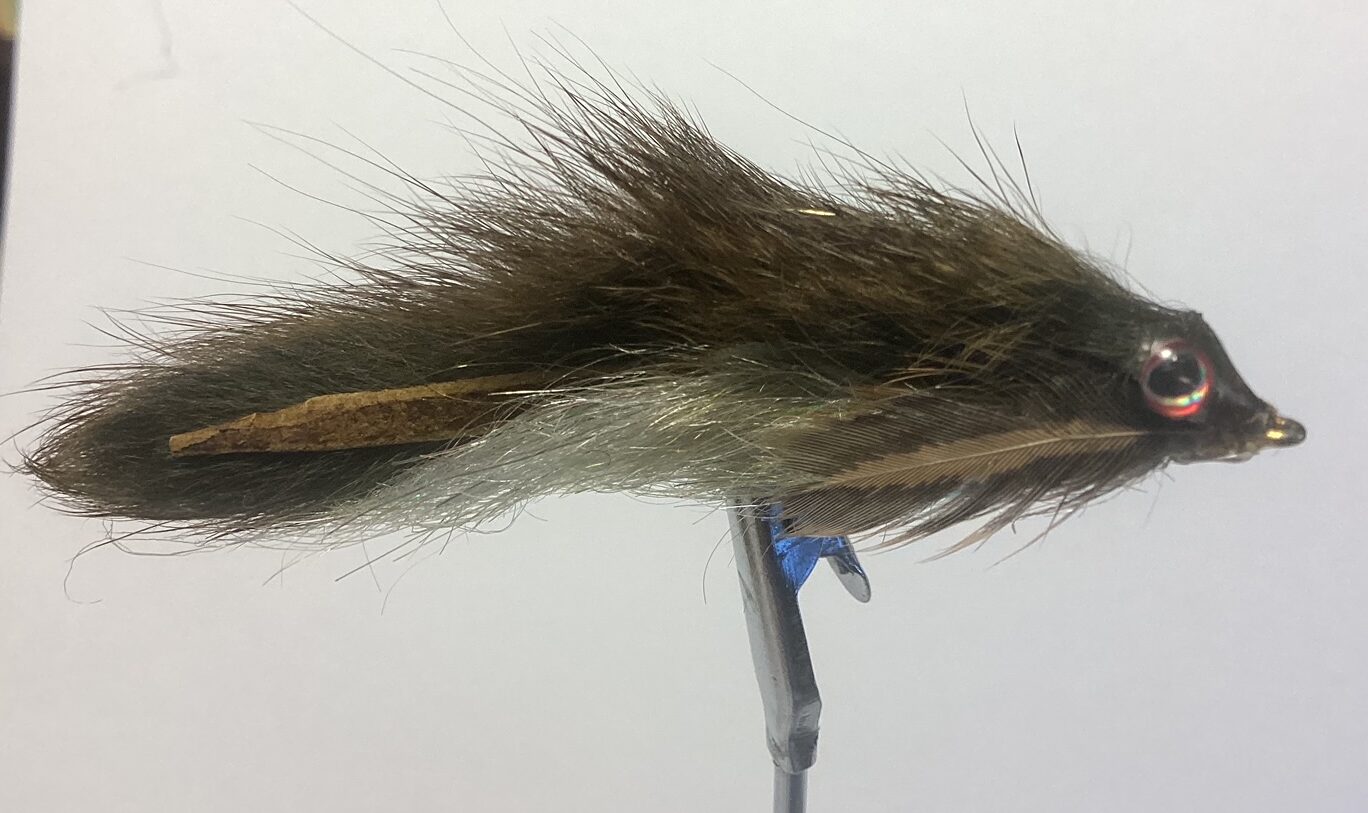
|
We welcome beginners and provide them with tools, thread and advice. It’s always helpful to bring magnification and a table lamp. Some lamps are always provided, but not enough to go around usually. Elaine Cook will be teaching. Sign ups are important and can be done at the September club meeting or calling Elaine at 831-234-6515. Please allow at least 24 hours notice ahead. |
Posted on November 29th, 2023
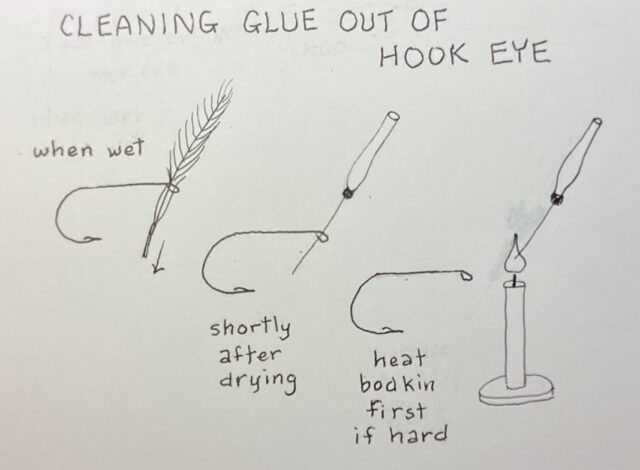
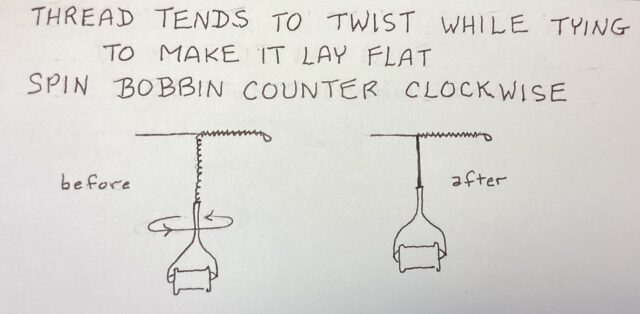
Posted on November 29th, 2023
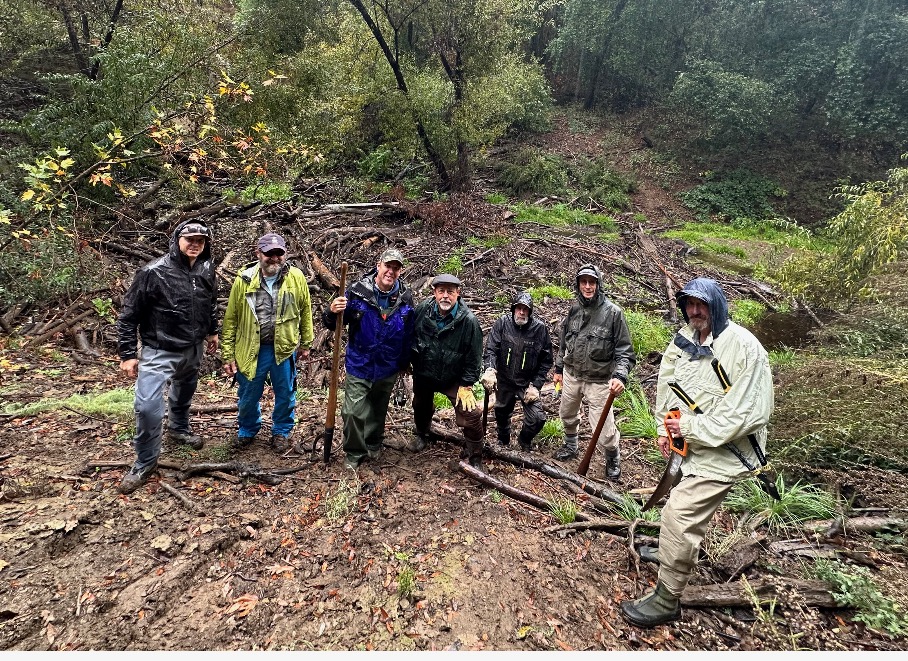
Volunteers from Santa Cruz Fly Fishing club were out last month getting wet and dirty to help our local Trout Unlimited chapter. Tim Frahm, Central Coast Steelhead Coordinator for Trout Unlimited has been working on a project on Little Arthur Creek—a tributary of the Pajaro River—in an ongoing effort to improve and sustain steelhead habitat. Little Arthur Creek contains the best remaining spawning habitat for native steelhead in the upper Pajaro River system. One of the obstacles to steelhead moving upstream is a dam on the creek that is slated to be removed in 2024. The dam does have a crude retrofitted fish ladder that does not look to be effective. Another problem with the dam is that it collects debris on the upstream side—especially during heavy rain events. These two issues make it very difficult—if not impossible—for migration of steelhead further upstream.
Six of our club members showed up with shovels, picks, saws and other assorted tools to remove all sorts of wooden obstacles—small and large—to open up the flow of the stream for passage of fish beyond the dam prior to its removal. After a few hours of vigorous effort, we were able to accomplish our task. It was rewarding to spend the morning with my fellow fly anglers trying to help in a worthy cause to restore native fish in a local watershed. Thanks to Kevin Murdock, Kevin Morrison, Tommy Polito, Barry Burt and Jerry McKeon from Santa Cruz Fly Fishing. Also, thanks to Tim Frahm and Chris Fischer from Trout Unlimited Steinbeck Chapter for inviting us. I hope we can continue our our involvement in bringing back these iconic native fish. Trout Unlimited is one of the organizations our club supports with contributions thanks to your membership, raffle purchases and fundraiser participation.
Posted on November 29th, 2023
| Date | Activity Link | Description | Location |
|---|---|---|---|
| Dec 18 - Dec 19 10:00 am - 12:00 pm | Spey Casting (See new dates) | Spey Casting clinics will be Monday, December 18 and Tuesday, December 19th . Saturday, December 2nd is CANCELLED. Keep an eye out for updates from Alex Ferber on Google Groups messages for times and locations. The Jade St. map is provided in case the class takes place there. Spey Casting is a style of presenting a fly in a down and across manner ( aka Swinging Flies)It utilizes special lines and facilitates casting in tight quarters. It enables one to use sinking lines and throwing larger flies with ease. It’s a technique used in fishing for Salmon, tout and Steelhead. It’ also has been used for Striped Bass and Shad.
| Jade Street Park baseball field |
| Dec 30 1:30 pm - 3:00 pm | Fly Casting Meetup | All are welcome from beginners to experienced casters. This is a good time to continue working on and enjoying your progress with effectively casting your fly-line -whether it’s 25, 35, 40, or 50 feet – 90% of your fishing casting. We will continue to work on this foundation for everyone who wants to successfully and enjoyably pickup their fly rod and cast exactly where you want – time after time. Bring your rod and reel if appropriate, and I will also have the nice club rods we have so you can toss one of those around too. | Jade Street Park baseball field |
Posted on November 29th, 2023
Next years dues for 2024 can be paid online now @ santacruzflyfishing.org/membership. 50% of our members have already renewed online and the response has exceeded last year with online renewals. Along with the renewals, we have had many generous donations included. We are grateful for your continued participation in the club.
Dues can also be paid @ the Dec meetings and also by check mailed to SCFF, PO Box 2008, Santa Cruz, Cal 95063
Posted on November 29th, 2023
The newsletter provides brief fishout info. For full detail, go to the website menu and select EVENTS -> Fishout Schedule
| EVENT NAME | EVENT DATE | SPECIES | FISH MASTER |
|---|---|---|---|
| 2023 Fishout Round-Up | Dec 01 - Dec 02 | FISH | Club Members |
| Upper Sacramento River Fishout (Dunsmuir) Date Postponed High Water | Mar 15 - Mar 17 | Trout | Alex Ferber |
| Pyramid Lake Fish-out April 1 – April 7, 2024 – New Info | Apr 01 - Apr 07 | Lahontan Cutthroat Trout | Mike White - (831) 706-5556 |
| Kelly Lake – Watsonville (bass, crappie) | Apr 20 | Bass, crappie, bluegill | Scott Kitayama |
| Rio Del Mar State Beach Surf Fishout | May 04 | Surf Perch / Striped Bass | Lance B. |
| June Surf Fishout – Beer Can Beach | Jun 01 | perch, stripers | Sam Bishop - Fishing; Mike Lovejoy - Breakfast |
| Burney and Around – UPDATED- | Jun 07 - Jun 09 | Trout | Alex Ferber |
| Clarks Fork Stanislaus River – Fishout (Stanislaus Fly Fishing Club) – UPDATED 6/11 – | Jun 14 - Jun 16 | Trout | Gus Link - Stanislaus Fly Fishing Club |
| Lake Almanor/Hex Hatch -June 22nd thru 29th- 2024 -UPDATED- | Jun 22 - Jun 29 | Trout | Tim Loomis |
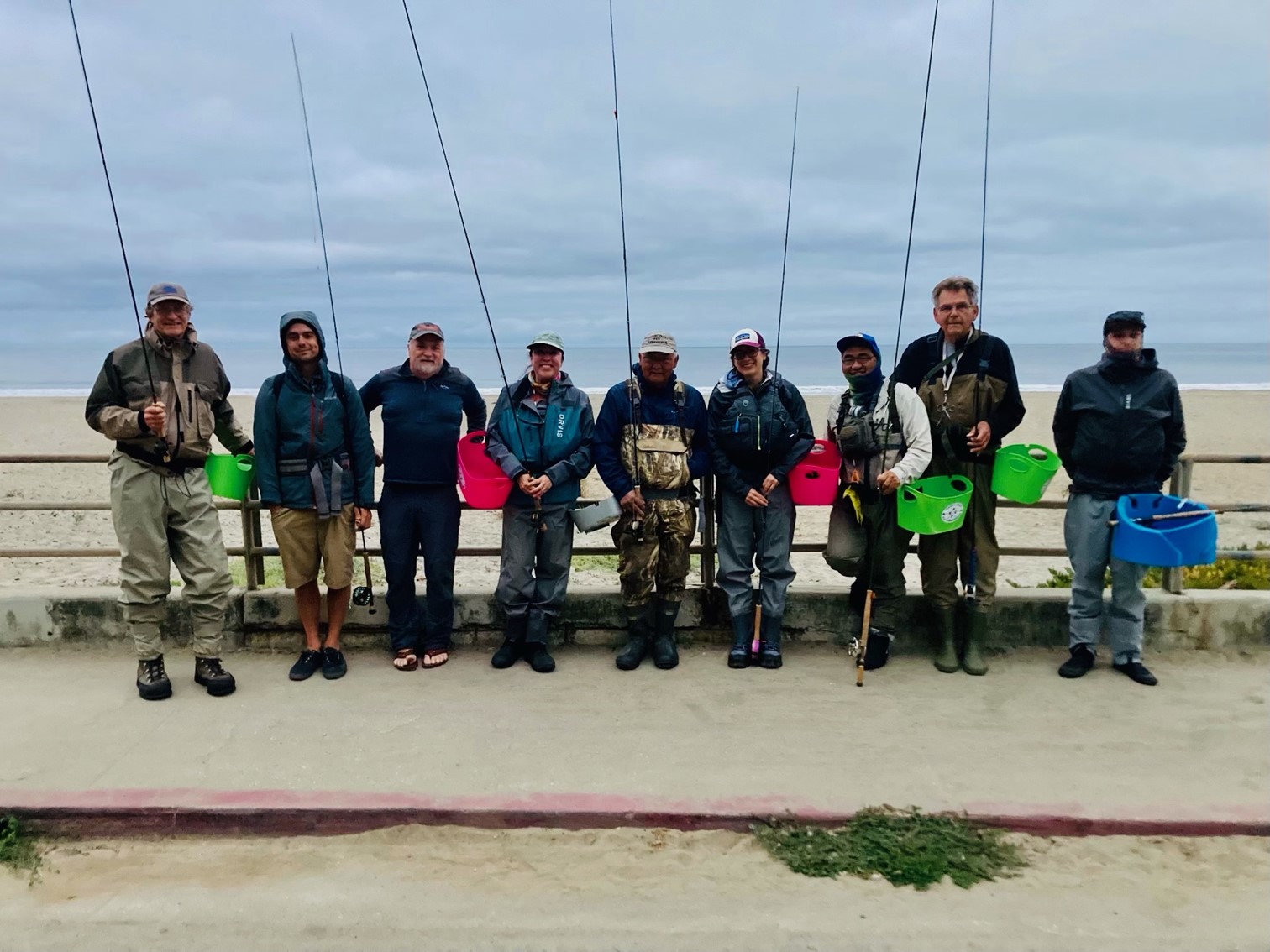


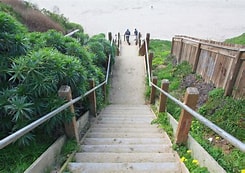

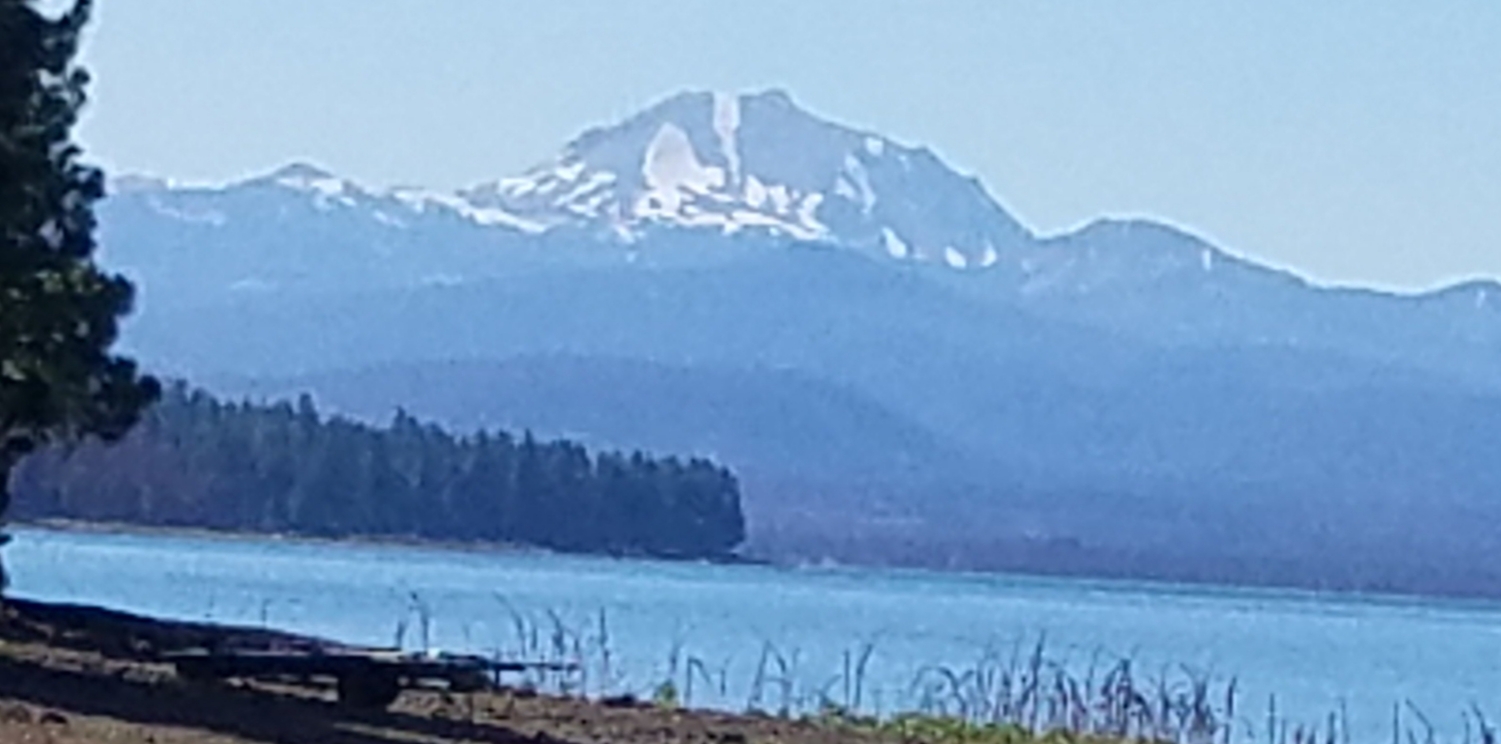
Posted on November 29th, 2023
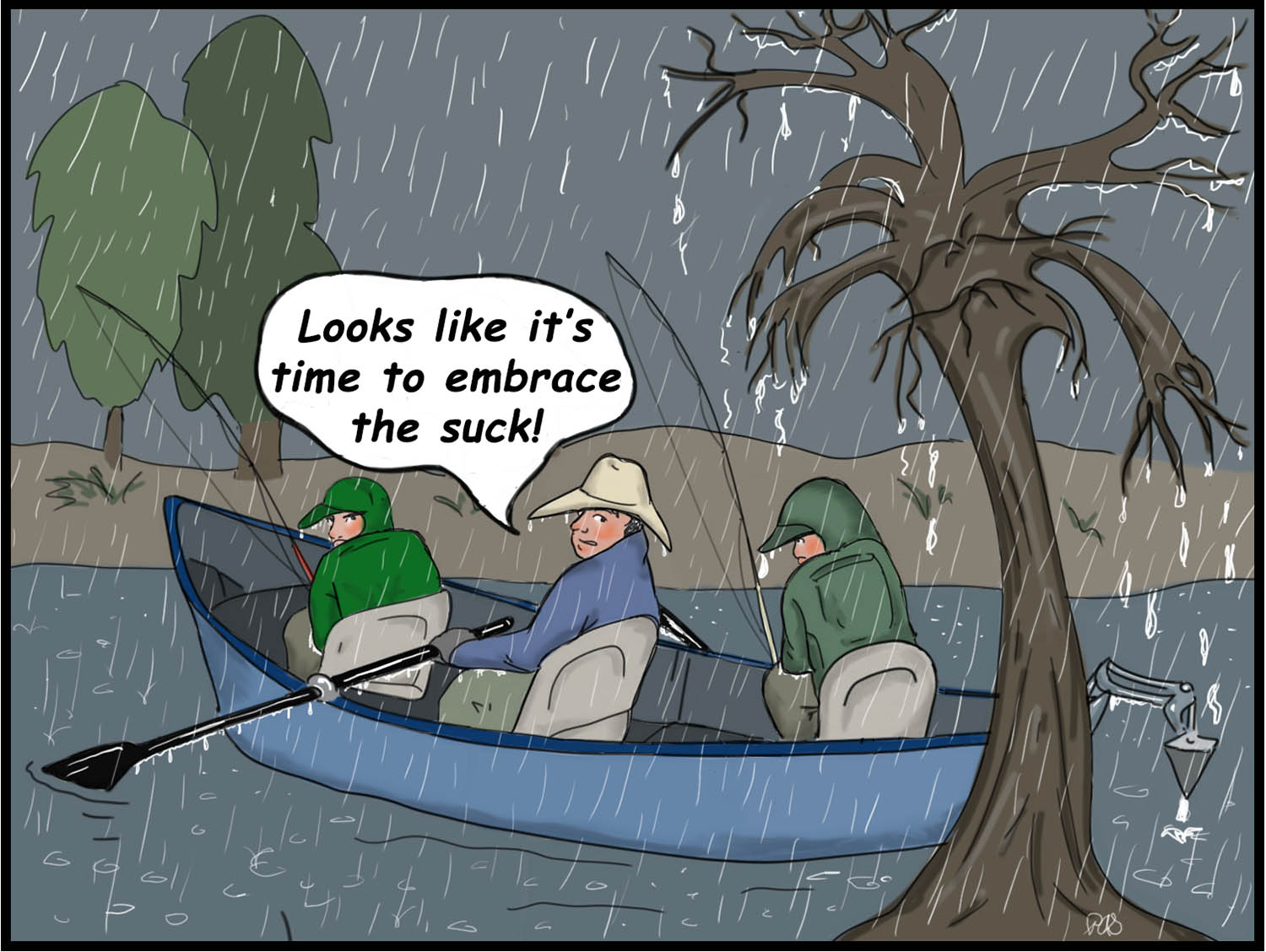
This one is for the steelhead fishers, who tell us all the time how much fun they’re having!
Posted on November 30th, 2023
General Meeting……………………
Conway Bowman ~ Fly Fishing for Mako Sharks
November Raffle……………………
President’s Line……………………
Fly Tying……………………
November Class: Wiggle Worm
Fly of the Month: Tiger & Zebra Midges
Conservation Concerns……………
SCFF Supports Organizations That Make a Difference
Membership Notes…………………
Club Activities – November
2024 membership renewals
2024 Annual Dinner & Fundraiser
Fishout Schedule…………………
Gone Fishing…………………
Last Surf Fishout of 2023
Thoughts on Mammoth
Cartoon ……………………
Solution to last month’s puzzle
Posted on October 26th, 2023
Zoom link: https://us06web.zoom.us/j/89352294939
Conway X Bowman is a USCG-licensed captain who pioneered fly fishing for Mako sharks over 27 years ago. has fly fished and guided around the globe from the jungles of Thailand to the remote lakes and rivers of Alaska.
Conway is regarded as one of the top fly fishing guides and anglers in the world. His pioneering of not only Mako sharks on the fly, but also West Coast saltwater fly fishing has been featured in many books, and he is the author of The Orvis Guide to Saltwater Fly fishing: 101 tips for the Absolute Beginner. Conway resides in the coastal town of Encinitas, California, with his marine biologist wife, Michelle, and their boys Maximillian and Jackson.
Conway will be joining the club virtually to speak about fly fishing for Mako Sharks just off the coast of San Diego.
| Monthly Speaker | Date | Excerpt |
|---|
Posted on October 26th, 2023
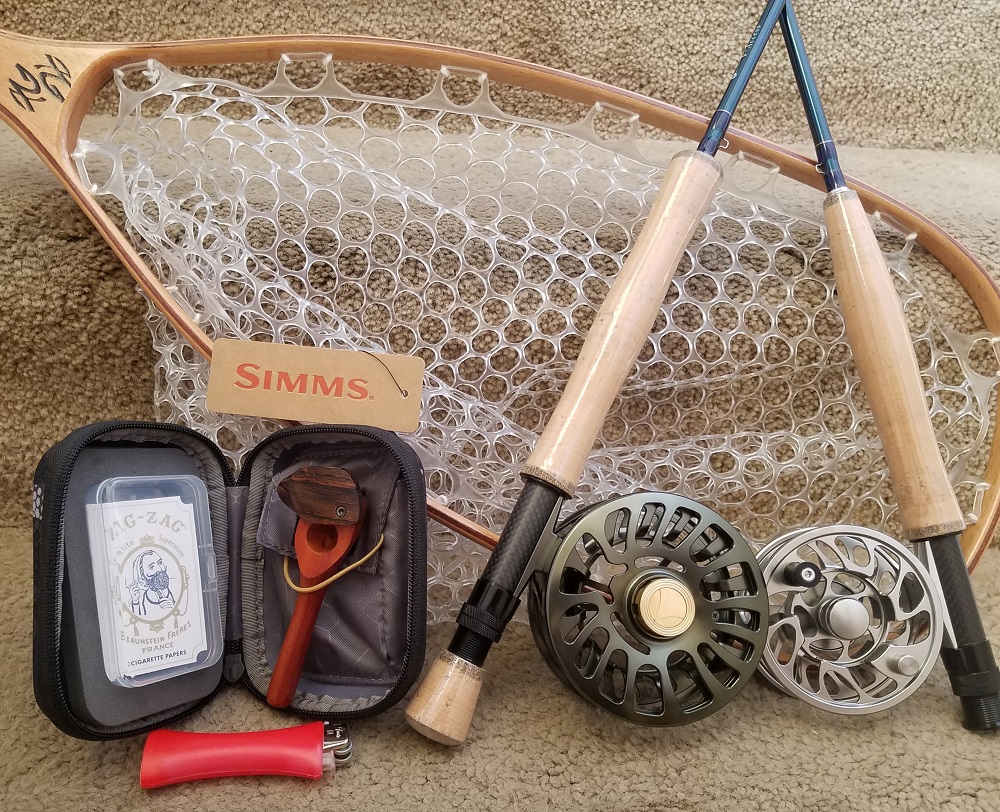
Rods/Reels: We will be giving away TWO! Rod/reel packages to our lucky ticket holders. Both packages are V-Access SK carbon 9 ft 4 section rods, choice of either 7wt or 5wt.
Net: Take a look at this long handle, long oval laminated wooden landing net. Nearly 3 feet in length, this net, with a clear fish friendly vinyl basket.
Fish Whistle: The Fish Whistle is the perfect addition to any trip that succeeds greater than all expectations or for that occasional adventure that does not turn out quite so well.
Raffle tickets are a dollar each, $20 bucks gets you 25. Click on the following link to purchase your lucky tickets.
The online ticket sales office will close at noon on Wednesday the day of the meeting. The drawing will take place at the monthly meeting (11/1/23) held at the Aptos Grange. Club membership not required to participate, need not be present to win.
Posted on October 26th, 2023
Thankful that:
and
Happy Thanksgiving,
Scott Kitayama
Posted on October 26th, 2023
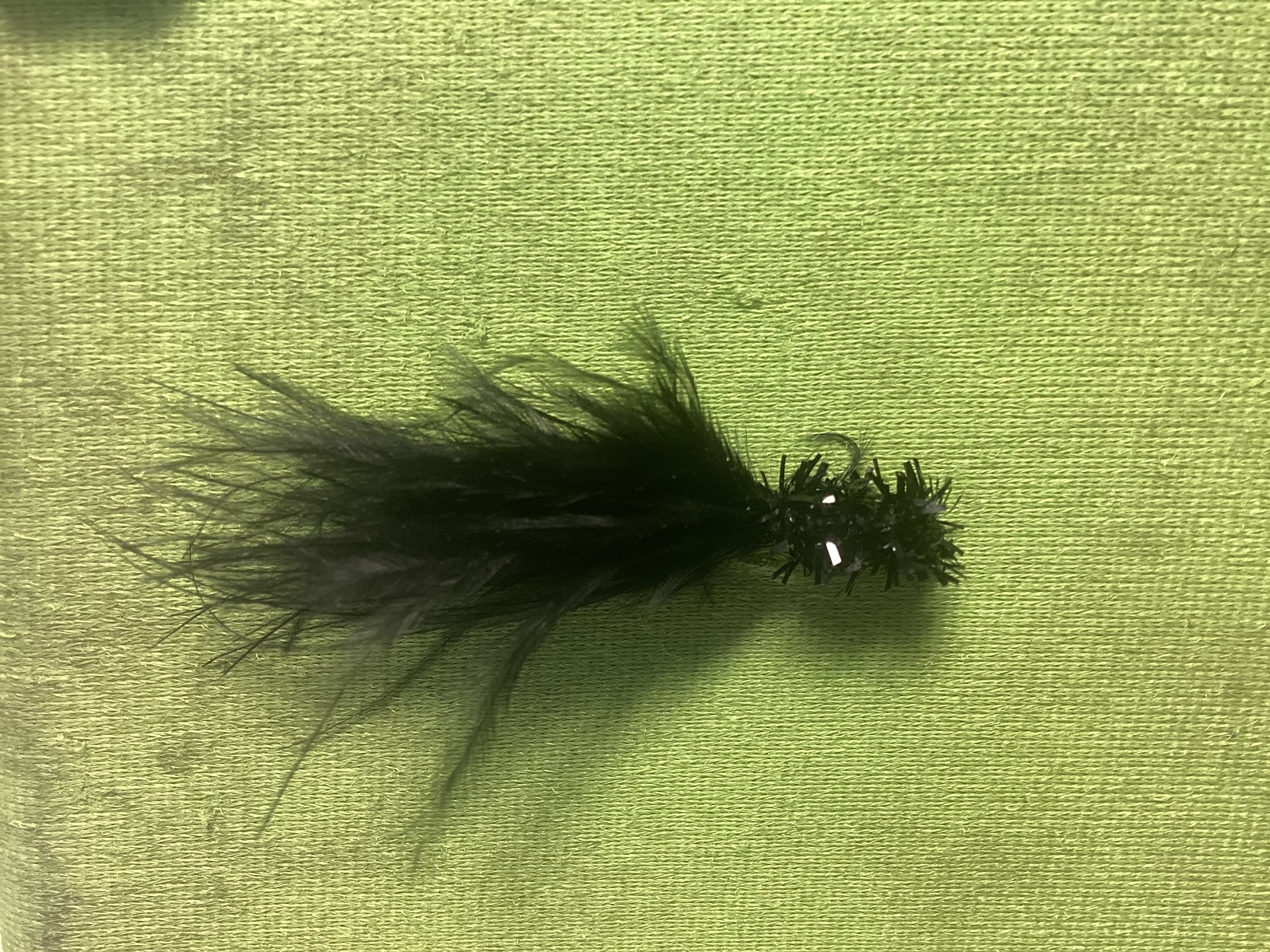
Our fly this month was originated by Jay Fair many years ago, and he’s considered one of the best stillwater fly fisherman there has been in Northern California. He passed away a number of years ago, but his flies and the materials that he developed are sought after even today. This is an easy fly to tie and is thought to be one of the most effective lake and pond fly patterns around. As always, the class is free and materials provided. If you have a black, six ought thread, please bring it, some will be available for beginners. You beginners ought to plan on attending this class, and tools and vises are available for you to use. Kathy Powers will be conducting the class this month. She is one of the most skilled fly tires we have in the club and loves to share her knowledge and skills with others. Signing up for the class, which is needed, can be done at the November club meeting or by calling Kathy at 831-316-2451 or myself, Elaine, at 831-234-6515 and no latter than 24 hours before the class.
Future tying classes. Dates and subject may change, please go to Fly Name to see more information.
| Date | Fly | Excerpt | |
|---|---|---|---|
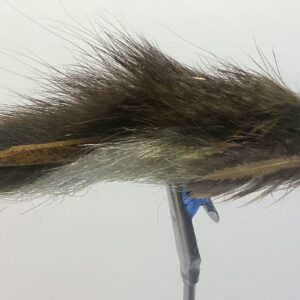 | Dec 13 6:30 pm - 8:30 pm | Trout Nugget - December Fly Tying Class | All club members are welcome! |
 | Jan 10 6:30 pm - 8:30 pm | Trout Nugget - January Fly Tying Class | All club members are welcome! |
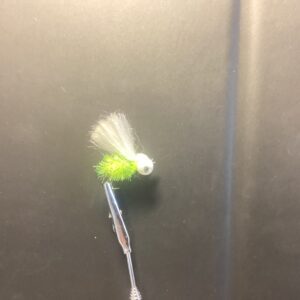 | Feb 14 6:30 pm - 8:30 pm | The Booby Fly - feb 24 | This fly originated in England, and became extremely popular until they outlawed because it was too successful. It is now becoming very popular in the states, and having the same results including at Pyramid Lake. We will be having a club fish out there in early April so be sure and bring a few of these flies with you. It’s tied in a variety of ways and we will be tying one that was particularly successful at Pyramid this last year. For those of you who are new to our club, the classes are always free with materials provided.For people who are new to fly tying, tools, vices, and thread are made available. For those who have thread bring white flat waxed nylon or similar. Our annual fundraiser of Salmon and big ralffle on the 3rd of February is taking the place of our club meeting so you will need to sign up by calling or emailing me. 831-234-6515, coookin@gmail.com MARCH FLY TYING CLASS: We will be doing our annual popper class and space is limited. It will be held the weekend of March 16 and 17th at my home. Two days are required, each about four hours, due to drying of paints and epoxies. No particular fly tying skill is needed for this class. If you wish to attend this class, you can sign up now to assure your place. Do call if you have questions.
|
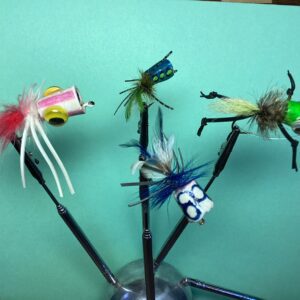 | Mar 16 - Mar 17 10:00 am - 3:00 pm | March Poppers Class! -2024 | It’s time to get ready for the bass and bluegill season with some of these top water creations. This is a two day class that is a very artsy crafty and beginners should feel comfortable in attending. All the materials will be provided including the thread. Vises and tools will be available for beginners. There is limited space, so only sign up if you are committed to attend and do so no later than March 11. You can sign up at the club meeting or by calling me at 831-234-6515 |
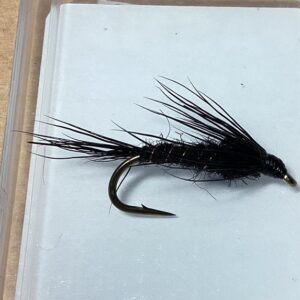 | Apr 10 6:30 pm - 8:30 pm | AP nymph | Looking ahead we will be tying a nymph that has been around for a long long time. It’s a great fly for beginners. |
Posted on October 26th, 2023

Midges are the most abundant food for trout. During the winter, it is their main source of food. They come in a great variety of sizes and colors. This pattern simulate the midge pupa stage, therefore is fish subsurface. The bead usually represents the air bubble that brings them to the surface to hatch out. These two particular patterns are very commonly used and are very effective. Their size has nothing to do with the size fish they catch.
HOOK: TMC 2457 or similar scud hook Sizes 16-22
Crimp barb.
BEAD: silver for zebra midge, gold for tiger midge. Use size chart online for comparison of hook size to bed size.
Feed bead onto hook, small opening first.
THREAD: black 6/0, 8/0 or 12/0 depending on size of hook.
Attach behind bead. Touching wraps to part way around bend of hook (see picture). Wrap back to bead.
RIB: silver for zebra midge, gold for tiger midge. Size medium, small, or fine, depending on size of hook.
Place on near side of hook shank, wrap in place back to rear thread wraps. make two thread wraps behind rib.
BODY: thread as above
At this point in going forward, spin bobbin counter clockwise to make thread lie flat. Wrap forward, beginning in front of wire up to bead with touching wraps. Wrap thread backward 3/4 of shank then forward to bead again. Then halfway back, then 1/4 back leaving thread, hanging behind bead.
RIB (continued) spiral wrap forward in about five wraps, each getting slightly further apart than the last. Tie off with several wraps behind wire and several in front of wire then one behind wire and one in front of wire. Twist wire in awinterhelicopter type motion to cut. Never use good scissors.
FINISH: make multiple thread wraps behind bead and covering tied off wire rib. Whip finish. Cut thread. Apply glue. Coat body with UV resin, or glue, or sally Hansen hard as nails.
Posted on October 26th, 2023
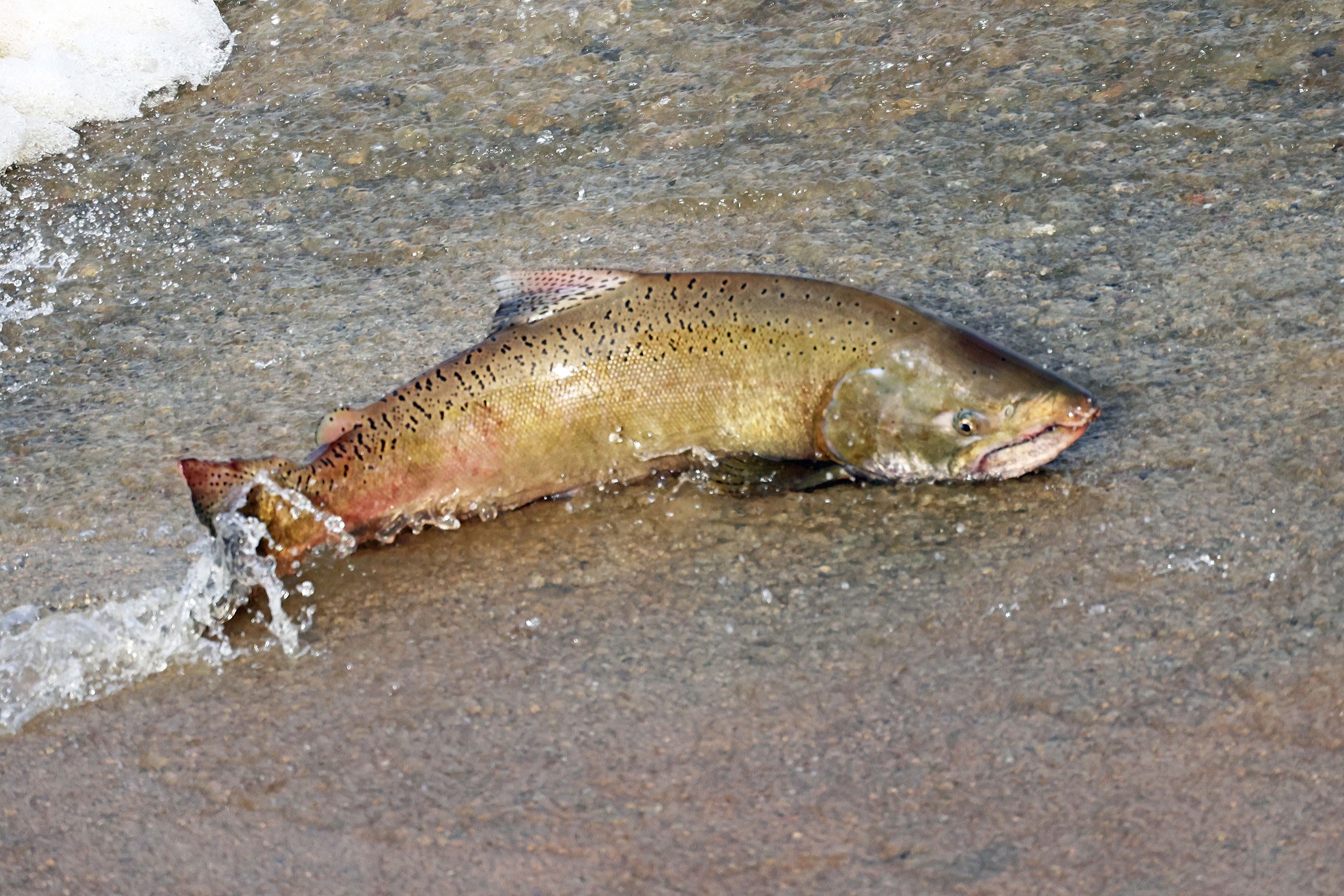
Two conservation organizations our club supports with annual donations—Alameda Creek Alliance and Caltrout—are working on a project to increase the habitat for Chinook salmon and steelhead on Alameda Creek. The goal of this project is to provide fish access to an additional 20 miles of the Alameda Creek watershed, into and above Sunol Regional Park. The obstacle to be addressed is a protective concrete pad over a main PG&E gas pipeline near the 680 freeway in Sunol Valley. The concrete crosses Alameda Creek at a level that blocks fish passage except during high streamflow events. The plan is to lower the pipeline 17 feet below the stream bed. Caltrout will be providing their resources to spearhead the project, and will lead stream monitoring after the obstacle is removed. This work builds on many projects on Alameda Creek over the years that resulted in Chinook salmon and steelhead being able to swim up into Niles Canyon in 2022—the first time in 50 years. Thank you SCFF club members for your support that enables us to pass along our success to organizations like Alameda Creek Alliance and Caltrout. To learn more about this, go to: http://www.alamedacreek.org/newsroom/pdf/media%20articles/2023/Cal%20Trout%209-18-23.pdf
Posted on October 26th, 2023
| Date | Activity Link | Description | Location |
|---|---|---|---|
| Nov 18 9:30 am - 3:00 pm | Volunteer With Trout Unlimited at Little Arthur Creek | SCFF volunteers will be helping Trout Unlimited remove a barrier to steelhead spawning habitat on Little Arthur Creek in the Pajaro River watershed. We currently have enough volunteers planning to help, but cancellations are possible. Contact Bob Garbarino if you are interested. rjgarbarino@gmail.com or 831-247-2045 | |
| Nov 18 1:30 pm - 3:00 pm | Fly Casting Meetup | Bring your lawn chair, lunch, and fly rod to practice casting with other SCFF club members. | Jade Street Park baseball field |
| Nov 19 9:00 am - 12:00 pm | Volunteer for Salinas River Cleanup, Sunday November 19th. | Join the Salinas Valley Fly Fishers for the annual clean up of the Salinas River fishing access. The event will be on Sunday November 19th starting at 9:00 am. Greg Smith is the Salinas Valley Fly Fishers representative for this event. Wear clothing for the weather of that day and if you can, bring gloves and a three prong hoe, as it’s the best tool. Directions:
| |
| Nov 19 9:00 am - 12:00 pm | Volunteer for Salinas River Cleanup, Sunday November 19th. | Join the Salinas Valley Fly Fishers for the annual clean up of the Salinas River fishing access. The event will be on Sunday November 19th starting at 9:00 am. Greg Smith is the Salinas Valley Fly Fishers representative for this event. Wear clothing for the weather of that day and if you can, bring gloves and a three prong hoe, as it’s the best tool. Directions:
|
Posted on October 26th, 2023
Next years dues for 2024 can be paid online now @ santacruzflyfishing.org/membership. 25% of our 225 members have already renewed online and the response has exceeded last year with online renewals.
Dues can also be paid @ the Nov and Dec meetings and by check mailed to SCFF, PO Box 2008, Santa Cruz, Cal 95063
Posted on October 26th, 2023
followed by
557 1/2 LAKEVIEW RD. , WATSONVILLE
ANNUAL. FUND RAISER COORDINATOR: DAVID SOUTH (831)713-5866 (831)234-0196
DINNER TICKETS: Are $40 and have already sold out..
VOLUNTEERS: Many long-term club members say that the best part of our event is the time volunteering, and working with others to put the whole event together. Contact Elaine Cook at (831)231-6515 or (831)-251-4741, or coookin@gmail.com (no text please) to find out how you can best help.
DONATIONS: Our club would be grateful for donations to be used as raffle prizes at our annual fundraiser. Examples: flies you have tied, other handcrafted items, business services, personal services such as fly-tying lessons, casting lessons, etc. If you have such a contribution, please contact our annual raffle coordinator Rick Chace, at (831)234-9200.
RAFFLE TICKETS: Can be purchased online when buying your dinner ticket (which will be issued at the door),or at our event. Two door prizes of 50 raffle tickets will be awarded, which should increase your chances of winning. There will be silent auction items as well.
ABOUT THE ROD AND GUN CLUB: it’s located in a rural setting overlooking Kelley lake. The parking lot is gravel so not a problem if it’s raining. Their insurance doesn’t permit us to bring alcohol. However, there is a cash bar where drinks and sodas can be purchased.
SO ALL IN ALL, COME SUPPORT YOUR CLUB, AND DON’T MISS OUT ON THE FUN.
Ticket purchasers : (as of Jan 25, 1:00 pm)
Asterisk means that the person paid by cash or check. Did not purchase through website.
Pajaro Valley Rod & Gun club is located 14 miles south of the Aptos Grange.

Posted on October 26th, 2023
The newsletter provides brief fishout info. For full detail, go to the website menu and select EVENTS -> Fishout Schedule
| EVENT NAME | EVENT DATE | SPECIES | FISH MASTER |
|---|---|---|---|
| 2023 Fishout Round-Up | Dec 01 - Dec 02 | FISH | Club Members |
| Upper Sacramento River Fishout (Dunsmuir) Date Postponed High Water | Mar 15 - Mar 17 | Trout | Alex Ferber |
| Pyramid Lake Fish-out April 1 – April 7, 2024 – New Info | Apr 01 - Apr 07 | Lahontan Cutthroat Trout | Mike White - (831) 706-5556 |
| Kelly Lake – Watsonville (bass, crappie) | Apr 20 | Bass, crappie, bluegill | Scott Kitayama |
| Rio Del Mar State Beach Surf Fishout | May 04 | Surf Perch / Striped Bass | Lance B. |



Posted on October 26th, 2023
It was a lot cooler at 6 am this morning than it is now on Saturday afternoon 10/7. But the catching wasn’t so hot (that’s why no perch pictures), except for Josh Wilkens arrived earliest and who caught that impressive Bat Ray that is already pictured on our website.
We had Will Murphy, Jerry McKeon, Matt Bohn, and Tommy Polito in addition to Josh out there and it was followed by a GREAT breakfast at Mike Lovejoy’s home, where we were also joined by our President, Scott. In the future, don’t miss “Breakfast at Lovejoy’s”.
What a great club we have. Today there are members fishing up at Mammoth, fishing today at the beach and spey cast lessons going on!
Posted on October 26th, 2023
From Club Member, Brad Elliot:
If you want to have a fun and enjoyable trout fishing experience, signup for the next Mammoth Fishout. John and Elaine Cook host this wonderful experience. They have been fishing this area for many years and know all the places to go, flies to use etc. etc. This was my second year in this gorgeous area in the fall of the eastern Sierras. I am an avid float tuber and my buddy Mike Lovejoy and I enjoyed some wonderful days on the beautiful mountain lakes catching rainbows up to 20″. What fun! The food and conversation over cocktails in the evening just add to the great fishing during the day.
From Fish Master, John Cook:
Elaine and I have been doing this for many many years, more like decades, and each year we find it entirely different than the last. The variables include personalities, the weather, fishing conditions, water levels, Crowley conditions, hatches etc. etc. etc. Even after all this time we love it and look forward to the next. And the best thing is, we always make some new friends. Hope you will be one of the anticipatory fishermen in 2024.
From Club Member, Scott Kitayama
Third year of going on the Mammoth fishing trip. My first two trips were primarily fishing lakes since the fishing was good, and the streams didn’t have much water. This year was exactly the opposite, the lakes were unfishable or I didn’t have much luck in them. However, the stream such as San Joaquin, Owens, Hot creek, McGee were all in good shape, and I had the chance to fish them with dry flies with John/Elaine Cook and Bob Garbarino . The weather was beautiful, Mammoth scenery is gorgeous, and small fish were willing to come up for flies. All in all it was a good trip and helped me learn how to be a better dry, fly fisherman.
Posted on October 26th, 2023
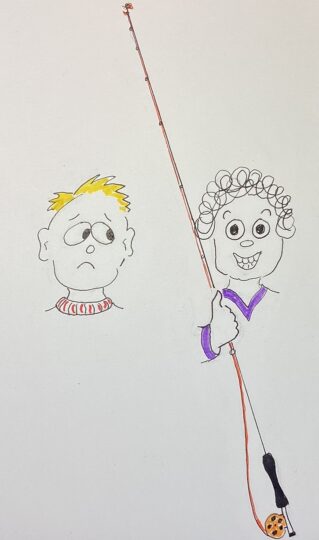
| Here are the correct answers: HOOK REEL FLY LINE | If you got all four correctly you get to go fishing. If not, go directly to the fly casting lessons and be taught by Tom Hogye our Fly Casting Master! |
Posted on October 26th, 2023
General Meeting……………………
Fly Fishing Film Tour Part 2
October Raffle……………………
President’s Line……………………
Fly Tying……………………
October Class: October Caddis
Fly of the Month: Scintilla Bubble
Conservation Concerns……………
Fly Fishing Conservation Best Practices
Membership Notes…………………
Club Activities – October
2024 membership renewals can be done online
Fishout Schedule…………………
Gone Fishing…………………
Upper Sac Fishout
Cartoon ……………………
A puzzle instead of a cartoon this month!
Posted on September 26th, 2023
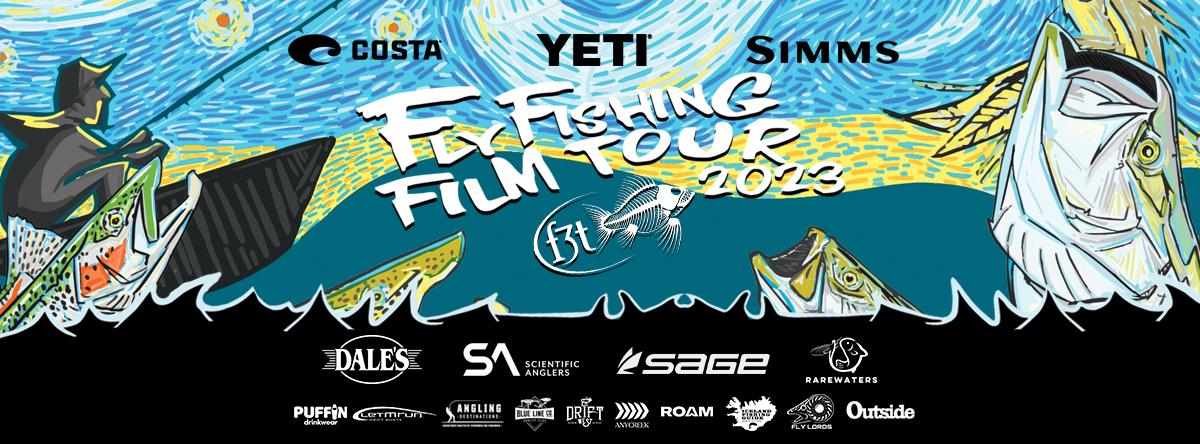
The Santa Cruz Fly Fishing Club presents the Part 2 of Fly Fishing Film Tours 2023 film line up at the Aptos Grange during the October general meeting. We want this to be a fun and exciting event and as a way of recruiting new club members. Please invite friends to come and watch the movie with you. No food and or drinks during the movie since we cannot have them in the main room of the Grange. However, we will have time after the film to visit and snack in the side room. We will have sodas and water for sale, if you want anything else, you need to bring it.
17th annual FLY FISHING FILM TOUR (F3T)
The 2023 show will feature locations from Cuba to Patagonia, Mexico to Australia, Alaska, Wyoming, the Deep South, Massachusetts and beyond. Experience the achievement of a permit slam, follow one man’s journey from Mexico to the waters of Wyoming, explore the best international waters and compete for the legendary belt buckle. Join us for a journey of adventure, friendship and the best fly fishing action.
The F3T is the original and largest fly fishing film event of its kind. Come for the action and stay for the giveaways and camaraderie that will feed your fishing addiction.
More info: https://flyfilmtour.com
Future Speakers. Dates and speakers may change, please go to URL to see the current information.
| Monthly Speaker | Date | Excerpt |
|---|
Posted on September 26th, 2023
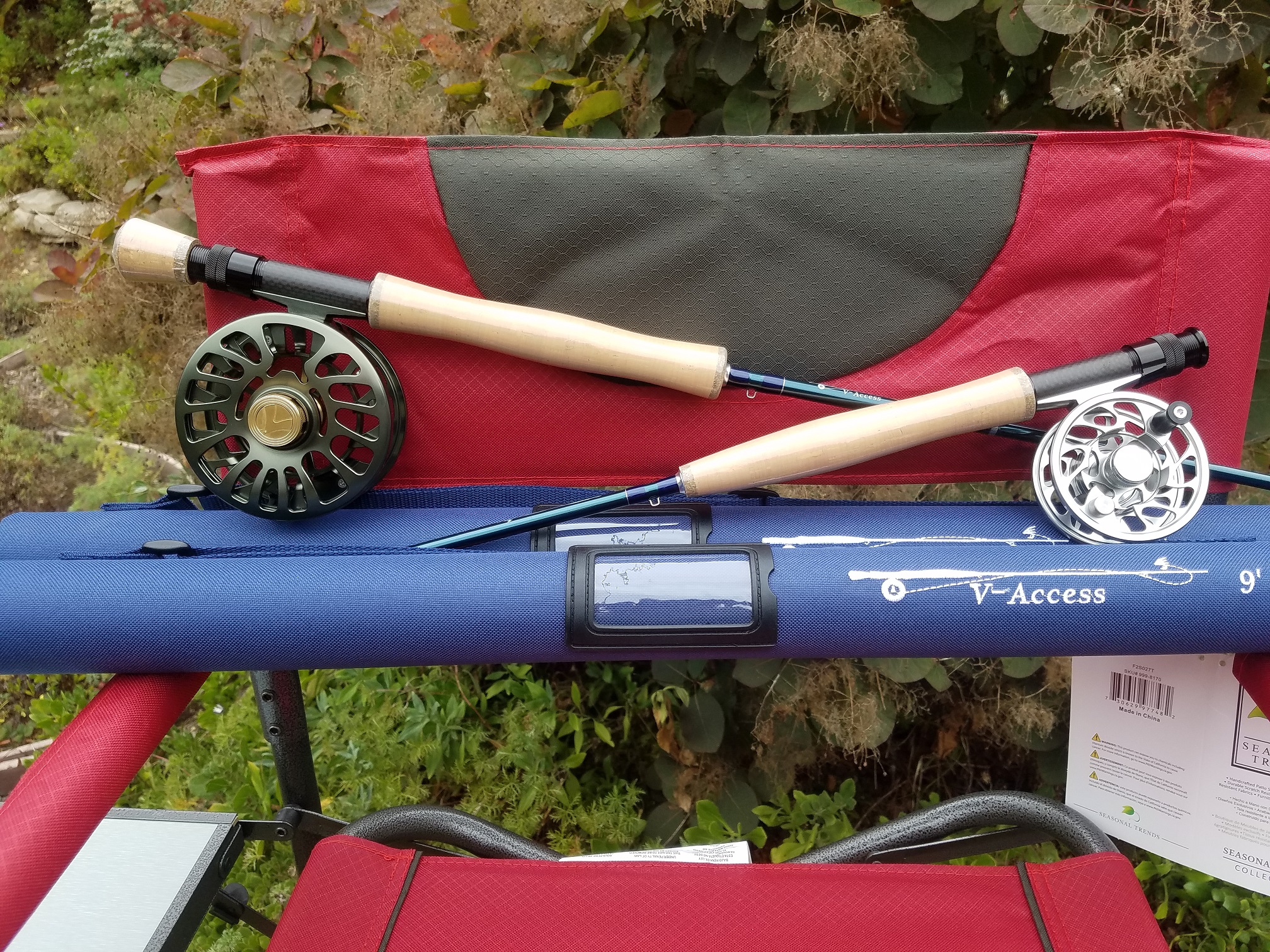
While some parts of the country see the Autumn as a time to stow the fishing gear and prepare for the long dark winter, we are blessed with some of the best fishing of the season. Think Stripers, steelhead, Pyramid giants just to name a few, then add quiet uncrowded Sierra streams to make us realize how fortunate we are.
That being said, how about some great raffle prizes?
This month we have a pair of Costa sunglasses, a heavy-duty folding camping chair or a choice of TWO V-access Rod & Reel Packages (9′ 8wt w/ arbor VII Reel or 8’6″ 4wt w/ 06N CNC Reel).
Don’t miss out, buy your lucky raffle tickets.
Raffle tickets cost a dollar each, $20 bucks gets you 25. Click on the following link to purchase your lucky raffle tickets:
https://www.santacruzflyfishing.org/product-category/raffle-prizes/
The online raffle ticket sales office will close at noon on Wednesday the day of the monthly meeting (10/4/23). Club membership is not required to participate, need not be present to win.
The prize drawing will take place at the regular meeting.
Posted on September 26th, 2023